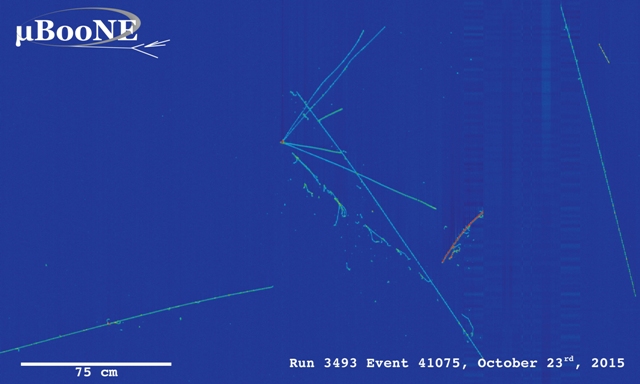Nov 25 2015
One hundred billion ghostly subatomic particles pass unnoticed through the tip of your finger every second. Chances are you’ll never see a neutrino, unless you’re a physicist.
 This display shows one of the first neutrino event candidates seen in the MicroBooNE detector. The invisible neutrino was incident from the left and interacted with an argon nucleus near the center of the image. (Image courtesy MicroBooNE)
This display shows one of the first neutrino event candidates seen in the MicroBooNE detector. The invisible neutrino was incident from the left and interacted with an argon nucleus near the center of the image. (Image courtesy MicroBooNE)
Last month, physicists from New Mexico State University were among scientists to see the first neutrinos in the MicroBooNE particle detector at the U.S. Department of Energy’s Fermi National Accelerator Laboratory near Chicago.
“The proton beam from Fermilab accelerator complex was switched on for MicroBooNE in mid-October, and we are very excited to see these first images from some of the clearest neutrino interactions in the detector,” said Stephen Pate, physics professor who, along with physics associate professor Vassili Papavassiliou, leads the NMSU High-Energy Nuclear Physics team in the College of Arts and Sciences.
Using one of the most sophisticated processing programs ever designed for a neutrino experiment, the computers sift through the thousands of interactions that occur every day and create 3-D images of the most interesting ones.
“Our group plays a central role in several aspects of the development and operation of the detector, including the understanding of the neutrino beam itself,” Pate said.
The MicroBooNE scientific collaboration consists of more than 100 physicists from 23 institutions from the U.S. and three other countries. The machine allows scientists to further study the properties of neutrinos, particles that may hold the key to understanding many unexplained mysteries of the universe.
The MicroBooNE detector – a 40-foot-long cylindrical metal tank designed to detect particles called neutrinos – was installed at the U.S. Department of Energy’s Fermilab site last year.
MicroBooNE’s detector is a liquid-argon time projection chamber. It resembles a silo lying on its side, but instead of grain, it’s filled with 170 tons of liquid argon.
Liquid argon is 40 percent denser than water so neutrinos are more likely to interact with it. When an accelerator-born neutrino hits the nucleus of an argon atom in the detector, its collision creates a spray of subatomic particle debris. Tracking these particles allows scientists to reveal the type and properties of the neutrino that produced them.
"This experiment utilizes a new technology in particle detectors for studies of neutrinos that is now coming of age,” said Papavassiliou. “It represents the first large-scale project in a series of experiments that are planned in the U.S. for the next several years as part of the country’s long-range plan for research in particle physics, with broad international participation as well.”
NMSU has a long history of collaboration with Fermilab and is a member of the Universities Research Association, a consortium of 86 research universities from around the world.
“We have a postdoctoral researcher, Tia Miceli, and a graduate student, Katherine Woodruff, in residence at Fermilab, working on the experiment full time,” Pate said. “Our involvement in the MicroBooNE experiment dates back to spring of 2012 when we joined the collaboration.” The NMSU team also includes undergraduate physics student Alistair McLean.
The 2015 Nobel Prize in physics was awarded for neutrino oscillations, a phenomenon that is of great importance to the field of elementary particle physics. Intense activity is under way worldwide to capture neutrinos and examine their behavior of transforming from one type to another. MicroBooNE is an example of a new liquid-argon detector being developed to further probe this phenomenon while reconstructing the particle tracks emerging from neutrino collisions as finely detailed three-dimensional images.
“The experiment has many goals, among them studying the properties of neutrinos, also the internal structure of the proton and also understanding the dynamics of atomic nuclei,” Pate added.
MicroBooNE’s findings will be relevant for the upcoming Deep Underground Neutrino Experiment, known as DUNE, which plans to examine neutrino transitions over longer distances and a much broader energy range. Scientists are also using MicroBooNE as a research and development platform for the large DUNE liquid-argon detectors.
“Future neutrino experiments will use this technology,” said Sam Zeller, Fermilab physicist and MicroBooNE co-spokesperson. “We’re learning a lot from this detector. It’s important not just for us, but for the whole physics community.”
The DOE is funding the NMSU group. The DOE and the National Science Foundation are funding the MicroBooNE experiment.